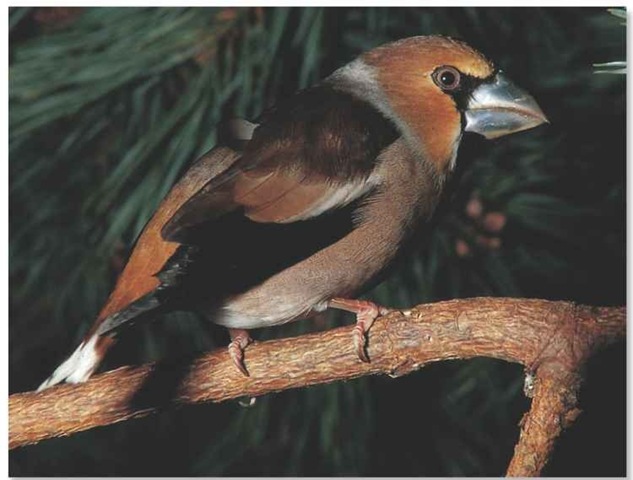ORDER
Passeriformes
FAMILY
Fringillidae
GENUS & SPECIES
KEY FEATURES
• Huge bill and powerful jaw muscles crack open hard seeds, especially fruit pits
• Shy and elusive, spending most of the time high in the treetops and avoiding open ground
• During courtship, the male performs elaborate displays using his wings
WHERE IN THE WORLD!
Found across much of temperate Europe and Asia and in northwestern Africa; absent from Ireland, Scotland and most of Scandinavia
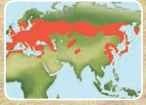
Lifecycle
A master seed buster, the hawfinch is a quiet resident of woodlands and orchards. With its outsize bill, stocky body and colorful wings, it could be easily mistaken for a small parrot.
HABITAT
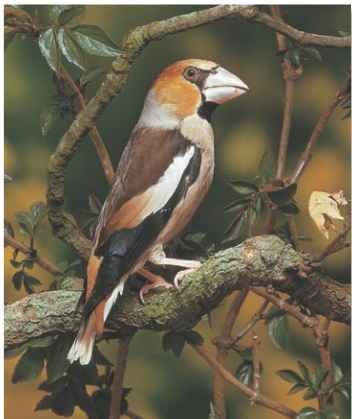
A Closed environment The hawfinch needs tree cover in its habitat.
Over its extensive range, the hawfinch is a characteristic bird of mature broad-leaved woodland, especially in open mixed oak and hornbeam forests. It also lives among other trees that provide large fruits to eat, particularly beech, ash, elm and maple or sycamore. Where it’s common, the hawfinch breeds in old orchards, in large gardens or parks, sometimes in towns and cities.
In the north, the hawfinch favors broad-leaved trees along rivers in otherwise coniferous woodland. In the south, it inhabits Mediterranean olive groves and orchards, steppe woodlands and thorn thickets fringing the North African deserts. The bird is found up mountains to the upper limit of broad-leaved woodland.
Local names for the hawfinch include berry breaker and cherry finch.
Experiments have shown that the hawfinch exerts a force of over 110 lbs. to crack open an olive stone — a feat for a bird weighing only 2 oz.
A feeding flock of hawfinches can sometimes be located by the sound of cracking fruit pits.
The hawfinch is generally nonmigratory, although some northerly birds winter south of their breeding ranges.
BREEDING

A Sharing duties The parents take turns feeding the chicks.
FOOD & FEEDING
The hawfinch feeds on tree seeds, such as those of hornbeam, beech and elm, and is also fond of fruit pits, such as cherries, holly, roses and hawthorns. In the Mediterranean, the hawfinch eats olive pits, acorns and the seeds of nettle trees. Like other finches, it grips small seeds in the grooves inside its beak while splitting and dehusking them, but uses the serrated edges at the back of the bill for clamping fruit pits and other large seeds.
GET CRACKING!
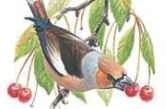
Picking…
A hawfinch plucks a cherry from a twig and peels off the flesh with the lower mandible.
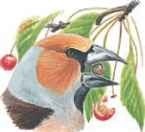
Gripping…
Holding the stone firmly, the bird uses incredible force to break the husk and get to the nutritious kernel.
The hawfinch pairs in winter or early spring. The male performs a waddling “penguin walk” to impress his intended mate, holding his body almost vertical and drooping his wings. He may also bow deeply lowering his bill until it’s almost between his legs and ruffling up the gray feathers at the back of his neck. In early stages of pair formation, a female may react aggressively. If the female relents, the pair performs a cautious bill-touching display The female builds the nest and takes sole responsibility for incubating her eggs (usually four or five) for two weeks. Both parents care for the hatchlings; the family may stay together until November
Starting out The chick leaves the nest after about 11 days.
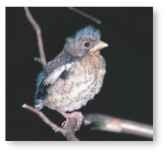
CONSERVATION
The hawfinch isn’t a threatened species. Its numbers have increased since the 1960s in parts of Europe, but have fallen in Britain because of the disappearance of old orchards.
BEHAVIOR
The hawfinch is a quiet bird, even in the breeding season. The male utters a simple, halting song from time to time in the trees. However, a flock of hawfinches makes hard, explosive ptik calls in flight. The hawfinch lives in pairs or family parties during the breeding
season and by the end of the summer, has begun to gather in flocks. By winter, large I flocks of 300 or more birds may gather in the most popular feeding sites.
Caught on the hop The hawfinch is wary when ground-feeding.

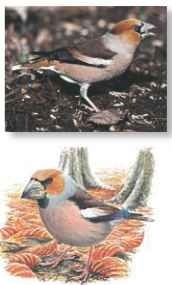
Down to earth In autumn, the ground is littered with fallen seeds.
Foraging…
Later, in beechwood where it lives, the hawfinch searches in the leaf litter for insects and fallen seeds.
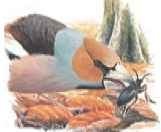
Snacking
Spotting some movement in the soil, the hawfinch hops forward and grasps a-beetle in its great bill.
Sharp edge The finely serrated bill helps the hawfinch grip seeds.

PROFILE
Hawfinch
The hawfinch’s superstrong bill, reinforced skull and thick neck enable it to feast on the seeds that are too tough for other birds to break into.
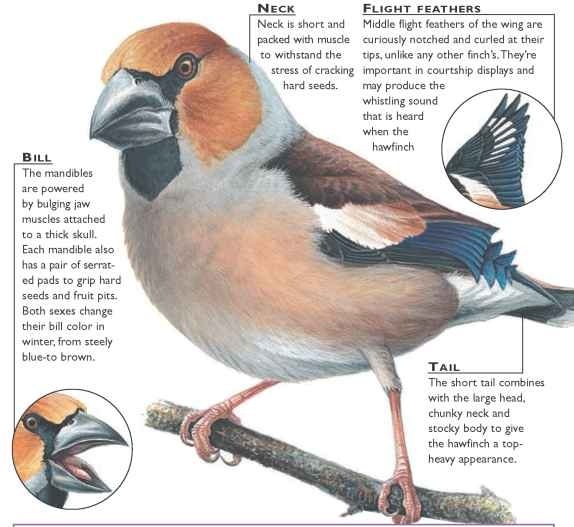
CREATURE COMPARISONS
Next to the great rosefinch (Carpodacus rubicilla), the hawfinch is the second-largest European finch. Another woodland finch is the bullfinch (Pyrrhula pyrrhula). Like the hawfinch, the bullfinch is thickset, but is smaller with a stubbier bill.This lets it strip buds rapidly from trees, but it can’t crack pits and large seeds like the hawfinch. Adult bullfinches share a glossy black cap and bib, white rump and black tail, but the male and female differ markedly, unlike the hawfinch: the bullfinch male has gray upperparts and pinkish-red underparts; the female and young birds are duller
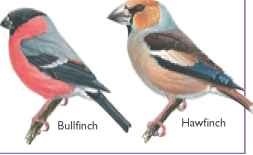
| VITAL STATISTICS Weight 1.5-2 oz. |
|
| Length | 7″ |
| SWlNGSPAN Sexual I Maturity |
12-13″ 1 year |
| Breeding Season | April-August |
| Number of Eggs | 2-7; usually 4-5 |
| Incubation Period | 11-13 days |
| Fledging Period | 12-13 days |
| Breeding Interval | 1 year |
| Typical Diet | Large tree seeds and fruit pits; also -tree buds and |
| shoots; insects | |
| Lifespan | Up to II years |
RELATED SPECIES
• Of the 124 species of finch in the family Fringillidae, 3 are fringilline species (2 chaffinches and : the brambling), while the rest are in the Carduelinae subfamily. The hawfinch is one of 9 similar species in the genus Coccothraustes, which also contains the beautiful evening grosbreak, C.-vespertinus, that visits feeders of the northern United States during the winter.
